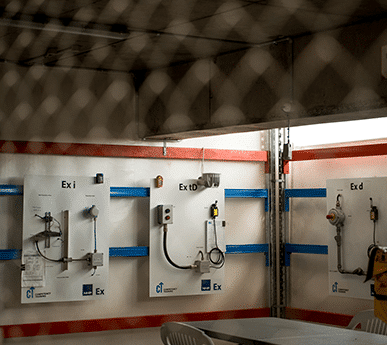Indicators on Roar Solutions You Need To Know
Wiki Article
Some Known Facts About Roar Solutions.
Table of ContentsThe smart Trick of Roar Solutions That Nobody is Talking AboutThe Main Principles Of Roar Solutions All about Roar Solutions
In such an environment a fire or surge is feasible when 3 fundamental conditions are met. This is frequently referred to as the "harmful location" or "combustion" triangular. In order to protect installments from a possible surge a technique of evaluating and identifying a possibly dangerous area is called for. The objective of this is to guarantee the proper selection and setup of equipment to inevitably avoid a surge and to guarantee security of life.
(https://www.pageorama.com/?p=roarsolutions)
No devices should be set up where the surface temperature level of the equipment is better than the ignition temperature of the offered danger. Below are some common dirt harmful and their minimal ignition temperature. Coal Dust 380C 225C Polythene 420C (thaws) Methyl Cellulose 420C 320C Starch 460C 435C Flour 490C 340C Sugar 490C 460C Grain Dirt 510C 300C Phenolic Material 530C > 450C Aluminium 590C > 450C PVC 700C > 450C Residue 810C 570C The possibility of the threat being present in a focus high enough to create an ignition will differ from area to area.
Hazardous location electrical equipment perhaps created for usage in greater ambient temperature levels. Area Repair By Authorised Personnel: Difficult testing might not be needed nonetheless details procedures may require to be followed in order for the tools to maintain its 3rd party score. Each item of tools with a dangerous ranking should be reviewed independently.
How Roar Solutions can Save You Time, Stress, and Money.
The equipment register is an extensive database of equipment records that includes a minimum set of areas to recognize each thing's place, technical specifications, Ex lover classification, age, and environmental data. This details is vital for monitoring and managing the tools properly within unsafe locations. In comparison, for regular or RBI tasting inspections, the grade will be a combination of Comprehensive and Close evaluations. The proportion of Detailed to Close evaluations will certainly be established by the Equipment Threat, which is examined based on ignition threat (the chance of a source of ignition versus the chance of a flammable ambience )and the harmful location category( Area 0, 1, or 2). This variation will certainly likewise influence the resourcing demands for job preparation. When Great deals are defined, you can create sampling plans based on the sample dimension of each Great deal, which describes the variety of arbitrary equipment items to be checked. To establish the needed sample dimension, two elements need to be evaluated: the size of the Great deal and the classification of evaluation, which suggests the degree of initiative that need to be used( lowered, typical, or boosted )to the examination of the Great deal. By combining the classification of inspection with the Great deal size, you can after that establish the appropriate being rejected standards for a sample, suggesting the allowable variety of malfunctioning products located within that example. For even more information on this procedure, please describe the Power Institute Guidelines. The IEC 60079 basic recommends that the optimum period between examinations should not surpass three years. EEHA assessments will likewise be conducted beyond RBI campaigns as component of set up upkeep and equipment overhauls or fixings. These assessments can be attributed towards the RBI example sizes within the impacted Lots. EEHA inspections are performed to recognize faults in electric devices. A heavy racking up system is vital, as a solitary piece of devices may have multiple mistakes, each with varying levels of ignition danger. If the mixed score of both examinations is much less than twice the fault rating, the Whole lot is deemed appropriate. If the Whole lot is still thought about undesirable, it needs to undergo a complete assessment or reason, which may activate more stringent evaluation protocols. Accepted Great deal: The sources of any kind of faults are recognized. If an usual failing setting is discovered, added equipment might need assessment and repair work. Faults are classified by seriousness( Safety, Integrity, House cleaning ), making sure that immediate concerns are evaluated and resolved without delay to alleviate any type of impact on safety or procedures. The EEHA data source must track and tape-record the lifecycle of mistakes together with the restorative activities taken. Executing a durable Risk-Based Assessment( RBI )strategy is critical for guaranteeing compliance and security in taking care of Electrical Equipment in Hazardous Locations( EEHA) (electrical refresher course). Automated Mistake Rating and Lifecycle Administration: Effortlessly handle faults and track their lifecycle to boost evaluation precision. The introduction of this support for risk-based assessment even more strengthens Inspectivity's placement as a best-in-class remedy for regulative conformity, as well as for any kind of asset-centric inspection use situation. If you are interested in finding out more, we invite you to request a presentation and find just how our remedy can change your EEHA monitoring processes.
The Best Strategy To Use For Roar Solutions

In terms of explosive risk, a dangerous area is a setting in which an eruptive atmosphere is existing (or may be expected to be existing) in quantities that need special precautions for the building, installment and usage of equipment. electrical refresher course. In this article we explore the difficulties faced in the work environment, the danger control actions, and the called for expertises to function safely
It is a consequence of modern-day life that we produce, save or take care of an array of gases or liquids that are regarded combustible, and a variety of dusts that are regarded flammable. These substances can, in particular conditions, form eruptive environments and these can have significant and tragic effects. A lot of us know with the fire triangular get rid of any one of the 3 aspects and the fire can not happen, but what does this mean in the context of harmful locations? When breaking this down into its easiest terms it is basically: a mix of a certain quantity of release or leak of a certain material or material, combining with ambient oxygen, and the presence of a resource of ignition.
In most circumstances, we can do little concerning the levels of oxygen in the air, however we can have considerable influence on sources of ignition, for instance electric devices. Hazardous locations are recorded on the hazardous area category illustration and are identified on-site by the triangular "EX LOVER" sign. Right here, amongst various other key information, areas are split right into 3 types depending upon the threat, the possibility and duration that an eruptive ambience will certainly exist; Area 0 or 20 is regarded one of the most hazardous and Area my site 2 or 22 is deemed the least.
Report this wiki page